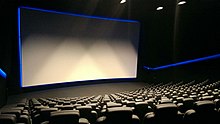Dolby Cinema
The Dolby Cinema is a premium cinema product from Dolby Laboratories , which is characterized in particular by the use of Dolby Vision and Dolby Atmos in combination with a special design of the cinema room. The minimum technical equipment and the design are determined by Dolby. The best known competitor is IMAX .
history
The first cinema with such a cinema opened on December 18, 2014 in Eindhoven , the Netherlands. This was followed by a cinema in Barcelona. At the start there were no projectors with Dolby Vision available, so some without Dolby Vision were used and then subsequently replaced by the appropriate projectors.
The first Dolby Cinema cinema in German-speaking countries was opened in Linz in 2015 . The second followed in 2016 in Salzburg . Both cinemas belong to the Cineplexx group. The first corresponding cinema in Germany was opened in May 2019 in the Mathäser Filmpalast in Munich .
technology
Projectors
It is mandatory to use two 4K 6P laser projectors with Dolby Vision, which were specially developed by Dolby and manufactured by Christie . These projectors are exclusively reserved for Dolby Cinema and are not sold without Dolby Cinema. Both projectors illuminate the screen equally, so that pixel on pixel. This is intended to double the brightness and thus increase the contrast. In addition, Dolby mentions a more pleasant feeling for the eyes due to less vibration of the picture. The higher brightness also has the advantage that no specially coated canvas is required for 3D presentations, which could easily falsify the image.
Dolby Vision is used when the footage offers this possibility. It is a competing product to HDR , but in contrast to HDR , this is a patented licensed product and use by studios and television manufacturers is therefore subject to a charge. Dolby Vision is characterized by a higher color depth (12 bit instead of 10 bit) and more detailed image information. With this technique, brightness information is stored in the metadata for each scene (or even for each image). This allows individual areas in the image to be darker and others to become lighter in order to obtain the image that is as rich in contrast as possible and that intended by the director.
The maximum resolution of the Dolby Vision technology is 7680 × 4320 pixels ( 8K , or four times the resolution of 4K), but this is not mandatory.
The 6P in the name of the projectors stands for the 3D technology used, in which the wavelength of the light was slightly changed in the image for the right eye compared to the image for the left eye in order to generate the brightest possible image, which is almost twice as much should be bright as with classic 3D projectors.
volume
The sound corresponds to the Dolby Atmos standard and should be as close as possible to that of the master sound track. With Dolby Atmos, speakers are attached to the sides, the back, the ceiling and also behind the screen to allow the sound to move as variably as possible in the room.
design
entrance
Dolby writes a special entrance area in front of which is called "Prelude" or "Audiopath". The entrance should get in the mood for the film and let the audience forget their worries as soon as they enter the hall. A kind of tunnel is built on the walls of which special scenes, mostly from the film, can be seen, which are accompanied by suitable acoustics. The tunnel does not have an entrance door at the beginning, it can only be found in the cinema.
Colours
The whole cinema is black. The only colored accent can be created by blue light sources. The cinema in Eindhoven even has a special permit from the fire brigade to switch off the emergency exit lighting during the performance in order to have a completely black hall.
Seating
The seating is slightly curved, rising more in height than normal and consists entirely of black, high, premium cinema seats. It should be possible to enjoy the film from every seat without twisting, but in some cinemas some seats can also be tilted.
room
The hall is particularly characterized by the hidden speakers. It shouldn't distract from the screen and the film, so the walls are completely smooth and have no protruding objects. The loudspeakers are therefore mounted behind a black fabric.
Installations (selection)
Status: June 2020
Germany:
- Munich (Mathäser Filmpalast)
- Hamburg ( Kinopolis Hafencity, planned for 2022)
Austria:
- Linz
- Salzburg
Netherlands:
- Eindhoven
- Hilversum
- The Hague
- Rotterdam
- Amsterdam
France:
- Paris
- Thiais
- Lyon
- Rouen
- Nice
- Toulouse
- Rennes
- Tremblay-en-France
England:
- London
- Leeds
Spain:
- Barcelona
Further installations exist in the USA (137 pieces), China (46 pieces), Dubai (three pieces), Japan and Kuwait (one each).
Individual evidence
- ^ Dolby launches advanced cinema experience. December 17, 2014, accessed June 3, 2020 .
- ↑ Dolby is launching its super-vivid IMAX theater competitor in the Netherlands. Retrieved June 3, 2020 .
- ↑ Austria's first Dolby Cinema in Linz | Cineplexx AT. Retrieved June 3, 2020 .
- ↑ New Dolby Cinema Cineplexx Salzburg Airport. July 4, 2016, accessed on June 3, 2020 (German).
- ↑ Abendzeitung Germany: Experience cinema like never before: Germany's first Dolby Cinema - from now on in Mathäser - Abendzeitung Munich. Retrieved June 3, 2020 .
- ↑ a b Nicolas La Rocco: Dolby Cinema: Germany's second cinema opens in Hamburg in 2022. Retrieved June 4, 2020 .
- ^ Cambridge Audio. August 7, 2017, accessed June 4, 2020 .
- ^ Dolby Cinema Locations. Retrieved June 4, 2020 .

